A Critical Evaluation of Circular Economy in the RMG Industry
VerifiedAdded on 2022/11/07
|10
|2369
|91
Report
AI Summary
This report critically evaluates the implementation of the circular economy within the Ready-Made Garments (RMG) industry. It explores the industry background, highlighting the environmental impact of high production and waste generation. The report defines the circular economy model as an alternative to the linear model, emphasizing resource reuse and sustainability. It analyzes the circular economy strategies of Nike and Aditya Birla Group, focusing on their effective resourcing practices, including material selection, lean production, and closed-loop systems. The analysis demonstrates how these companies are working to narrow, slow, and close the resource loop. The report concludes by emphasizing the importance of circular economy adoption for mitigating environmental impacts and ensuring long-term sustainability within the RMG industry.
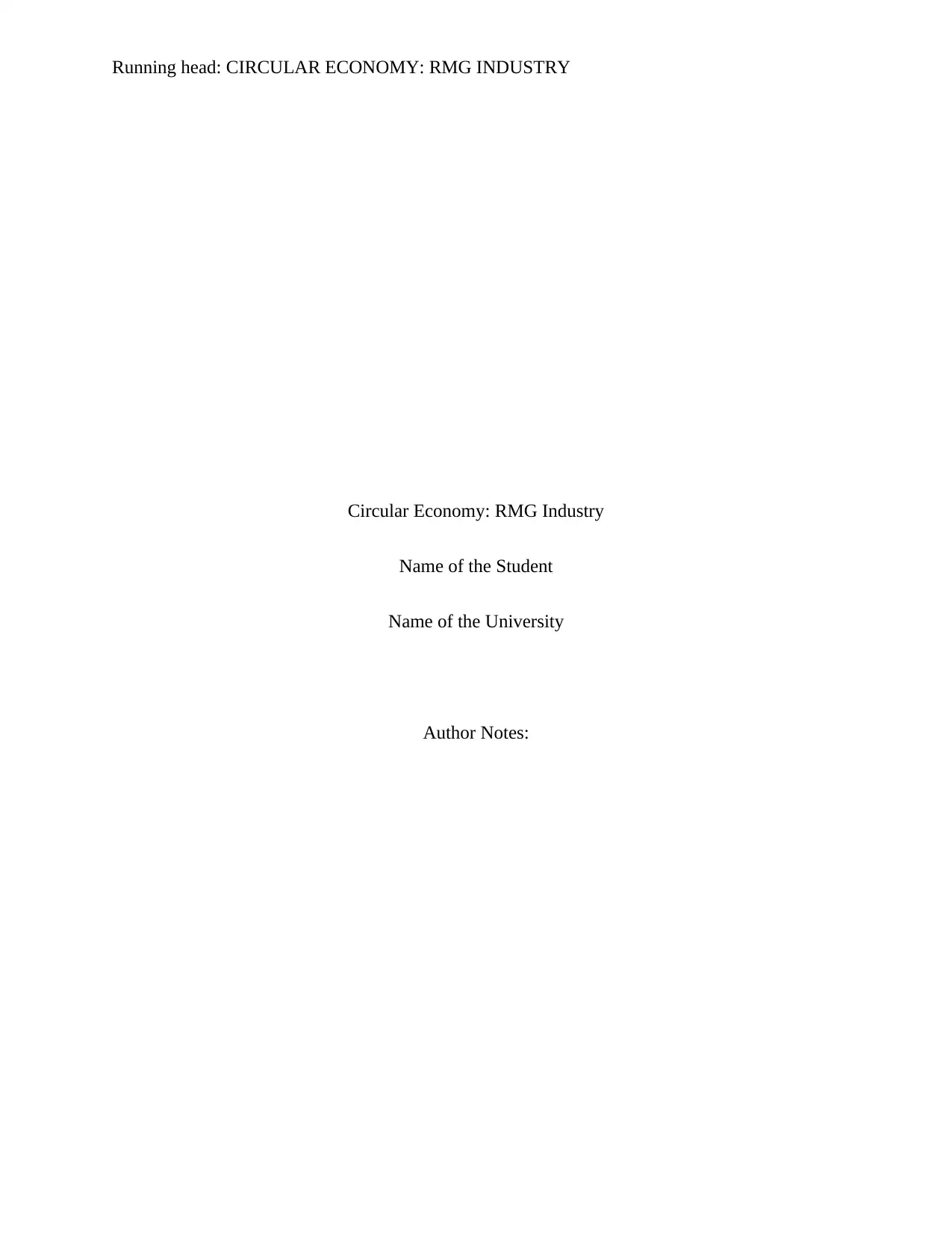
Running head: CIRCULAR ECONOMY: RMG INDUSTRY
Circular Economy: RMG Industry
Name of the Student
Name of the University
Author Notes:
Circular Economy: RMG Industry
Name of the Student
Name of the University
Author Notes:
Paraphrase This Document
Need a fresh take? Get an instant paraphrase of this document with our AI Paraphraser

1CIRCULAR ECONOMY: RMG INDUSTRY
Table of Contents
Introduction......................................................................................................................................2
Discussion........................................................................................................................................2
Industry background....................................................................................................................2
Circular Economy........................................................................................................................4
Effective Resourcing Practices....................................................................................................5
Conclusion.......................................................................................................................................7
REFERENCES................................................................................................................................8
Table of Contents
Introduction......................................................................................................................................2
Discussion........................................................................................................................................2
Industry background....................................................................................................................2
Circular Economy........................................................................................................................4
Effective Resourcing Practices....................................................................................................5
Conclusion.......................................................................................................................................7
REFERENCES................................................................................................................................8

2CIRCULAR ECONOMY: RMG INDUSTRY
Introduction
The Ready-Made Garments industry is heavily endorsed. High demand in the industry is
resulting in high profitability. The constant demand for new garments has resulted in the creation
of garments in abundance. It can be opined that the rise in demand in the ready-made garments
or RMG industry has been as a result of the increase in the population of the world as a whole.
As a result of the high demand witnessed in the industry, the industry is deemed to be highly
attractive. The latter, coupled with the fact that the industry has showcased favourable nature of
outcomes, determine the increasing urge of investment in the particular industry. However, it
must be identified that due to the high demand and productivity of the industry, a high amount of
resources are being used in the industry. Furthermore, it has been found that there is a high
degree of wastage in the industry that is disrupting the quality of the environment. As a result of
the harmful outcomes that the environment is subject to, there are various NGOs that have been
formed to reduce the negative implications suffered by nature (Rodríguez et al., 2016). The
circular economy concepts are being rigorously adopted by companies in the industry, and the
latter is also backed up by renowned organisations. The paper will critically evaluate the scope of
operations of Nike Inc. and ADITYA BIRLA GROUP in terms of narrowing down, slowing and
closing the loop in abiding by the concepts of circular economy in accordance with the RMG
industry.
Discussion
Industry background
It is impossible to imagine a world without the Ready-Made Garments industry. Such has
been the dependence that the human race has been able to develop with the said industry. As a
Introduction
The Ready-Made Garments industry is heavily endorsed. High demand in the industry is
resulting in high profitability. The constant demand for new garments has resulted in the creation
of garments in abundance. It can be opined that the rise in demand in the ready-made garments
or RMG industry has been as a result of the increase in the population of the world as a whole.
As a result of the high demand witnessed in the industry, the industry is deemed to be highly
attractive. The latter, coupled with the fact that the industry has showcased favourable nature of
outcomes, determine the increasing urge of investment in the particular industry. However, it
must be identified that due to the high demand and productivity of the industry, a high amount of
resources are being used in the industry. Furthermore, it has been found that there is a high
degree of wastage in the industry that is disrupting the quality of the environment. As a result of
the harmful outcomes that the environment is subject to, there are various NGOs that have been
formed to reduce the negative implications suffered by nature (Rodríguez et al., 2016). The
circular economy concepts are being rigorously adopted by companies in the industry, and the
latter is also backed up by renowned organisations. The paper will critically evaluate the scope of
operations of Nike Inc. and ADITYA BIRLA GROUP in terms of narrowing down, slowing and
closing the loop in abiding by the concepts of circular economy in accordance with the RMG
industry.
Discussion
Industry background
It is impossible to imagine a world without the Ready-Made Garments industry. Such has
been the dependence that the human race has been able to develop with the said industry. As a
⊘ This is a preview!⊘
Do you want full access?
Subscribe today to unlock all pages.

Trusted by 1+ million students worldwide
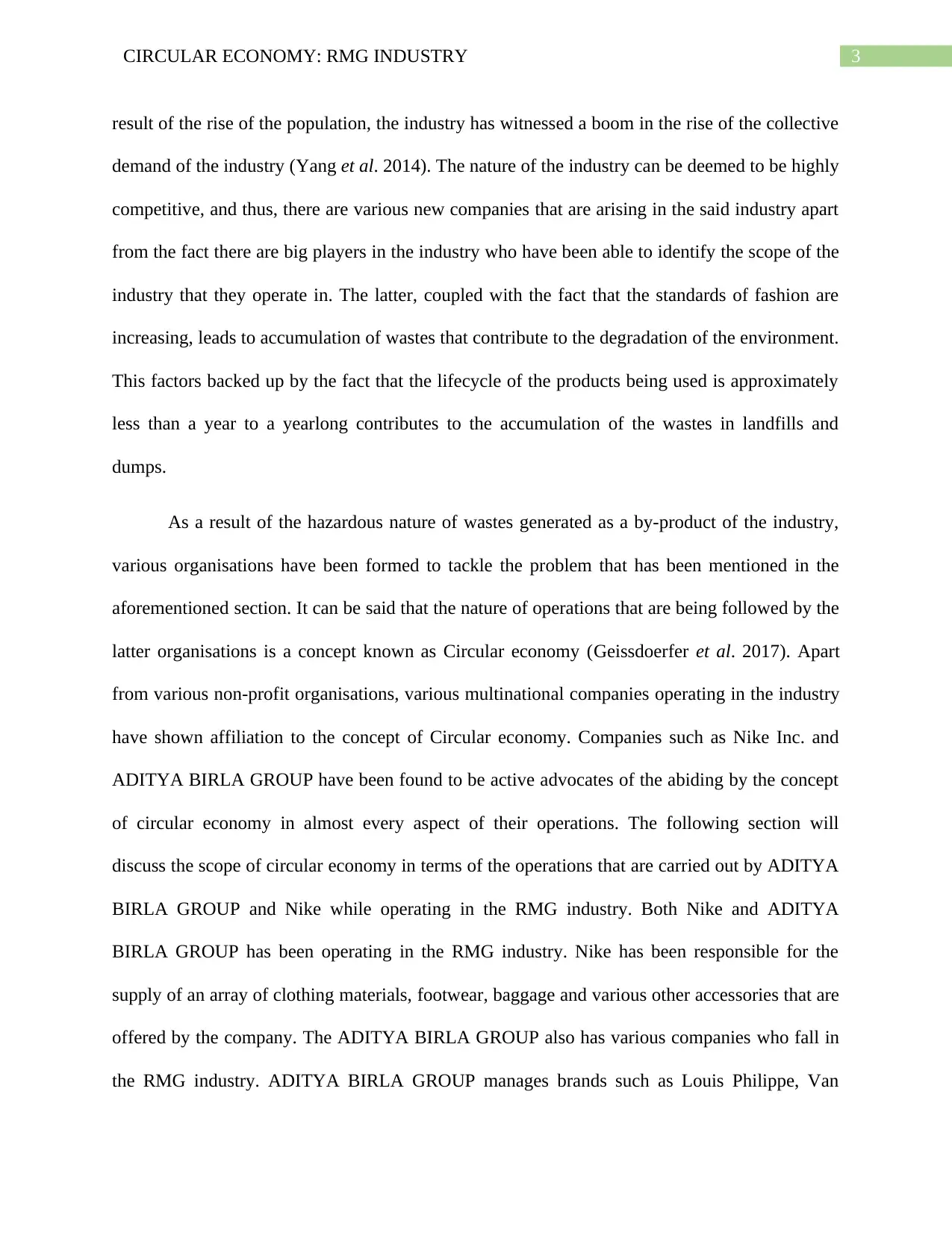
3CIRCULAR ECONOMY: RMG INDUSTRY
result of the rise of the population, the industry has witnessed a boom in the rise of the collective
demand of the industry (Yang et al. 2014). The nature of the industry can be deemed to be highly
competitive, and thus, there are various new companies that are arising in the said industry apart
from the fact there are big players in the industry who have been able to identify the scope of the
industry that they operate in. The latter, coupled with the fact that the standards of fashion are
increasing, leads to accumulation of wastes that contribute to the degradation of the environment.
This factors backed up by the fact that the lifecycle of the products being used is approximately
less than a year to a yearlong contributes to the accumulation of the wastes in landfills and
dumps.
As a result of the hazardous nature of wastes generated as a by-product of the industry,
various organisations have been formed to tackle the problem that has been mentioned in the
aforementioned section. It can be said that the nature of operations that are being followed by the
latter organisations is a concept known as Circular economy (Geissdoerfer et al. 2017). Apart
from various non-profit organisations, various multinational companies operating in the industry
have shown affiliation to the concept of Circular economy. Companies such as Nike Inc. and
ADITYA BIRLA GROUP have been found to be active advocates of the abiding by the concept
of circular economy in almost every aspect of their operations. The following section will
discuss the scope of circular economy in terms of the operations that are carried out by ADITYA
BIRLA GROUP and Nike while operating in the RMG industry. Both Nike and ADITYA
BIRLA GROUP has been operating in the RMG industry. Nike has been responsible for the
supply of an array of clothing materials, footwear, baggage and various other accessories that are
offered by the company. The ADITYA BIRLA GROUP also has various companies who fall in
the RMG industry. ADITYA BIRLA GROUP manages brands such as Louis Philippe, Van
result of the rise of the population, the industry has witnessed a boom in the rise of the collective
demand of the industry (Yang et al. 2014). The nature of the industry can be deemed to be highly
competitive, and thus, there are various new companies that are arising in the said industry apart
from the fact there are big players in the industry who have been able to identify the scope of the
industry that they operate in. The latter, coupled with the fact that the standards of fashion are
increasing, leads to accumulation of wastes that contribute to the degradation of the environment.
This factors backed up by the fact that the lifecycle of the products being used is approximately
less than a year to a yearlong contributes to the accumulation of the wastes in landfills and
dumps.
As a result of the hazardous nature of wastes generated as a by-product of the industry,
various organisations have been formed to tackle the problem that has been mentioned in the
aforementioned section. It can be said that the nature of operations that are being followed by the
latter organisations is a concept known as Circular economy (Geissdoerfer et al. 2017). Apart
from various non-profit organisations, various multinational companies operating in the industry
have shown affiliation to the concept of Circular economy. Companies such as Nike Inc. and
ADITYA BIRLA GROUP have been found to be active advocates of the abiding by the concept
of circular economy in almost every aspect of their operations. The following section will
discuss the scope of circular economy in terms of the operations that are carried out by ADITYA
BIRLA GROUP and Nike while operating in the RMG industry. Both Nike and ADITYA
BIRLA GROUP has been operating in the RMG industry. Nike has been responsible for the
supply of an array of clothing materials, footwear, baggage and various other accessories that are
offered by the company. The ADITYA BIRLA GROUP also has various companies who fall in
the RMG industry. ADITYA BIRLA GROUP manages brands such as Louis Philippe, Van
Paraphrase This Document
Need a fresh take? Get an instant paraphrase of this document with our AI Paraphraser
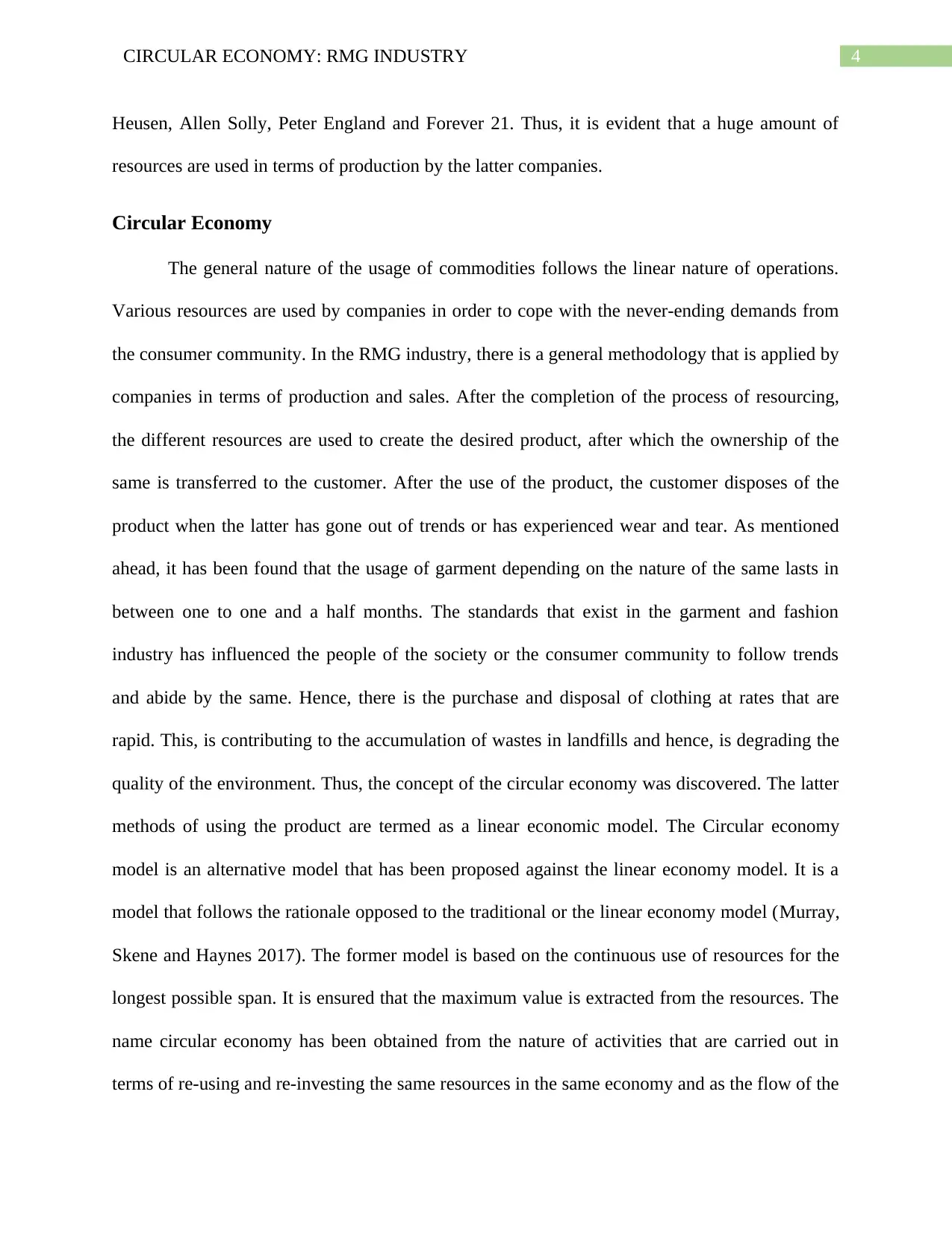
4CIRCULAR ECONOMY: RMG INDUSTRY
Heusen, Allen Solly, Peter England and Forever 21. Thus, it is evident that a huge amount of
resources are used in terms of production by the latter companies.
Circular Economy
The general nature of the usage of commodities follows the linear nature of operations.
Various resources are used by companies in order to cope with the never-ending demands from
the consumer community. In the RMG industry, there is a general methodology that is applied by
companies in terms of production and sales. After the completion of the process of resourcing,
the different resources are used to create the desired product, after which the ownership of the
same is transferred to the customer. After the use of the product, the customer disposes of the
product when the latter has gone out of trends or has experienced wear and tear. As mentioned
ahead, it has been found that the usage of garment depending on the nature of the same lasts in
between one to one and a half months. The standards that exist in the garment and fashion
industry has influenced the people of the society or the consumer community to follow trends
and abide by the same. Hence, there is the purchase and disposal of clothing at rates that are
rapid. This, is contributing to the accumulation of wastes in landfills and hence, is degrading the
quality of the environment. Thus, the concept of the circular economy was discovered. The latter
methods of using the product are termed as a linear economic model. The Circular economy
model is an alternative model that has been proposed against the linear economy model. It is a
model that follows the rationale opposed to the traditional or the linear economy model (Murray,
Skene and Haynes 2017). The former model is based on the continuous use of resources for the
longest possible span. It is ensured that the maximum value is extracted from the resources. The
name circular economy has been obtained from the nature of activities that are carried out in
terms of re-using and re-investing the same resources in the same economy and as the flow of the
Heusen, Allen Solly, Peter England and Forever 21. Thus, it is evident that a huge amount of
resources are used in terms of production by the latter companies.
Circular Economy
The general nature of the usage of commodities follows the linear nature of operations.
Various resources are used by companies in order to cope with the never-ending demands from
the consumer community. In the RMG industry, there is a general methodology that is applied by
companies in terms of production and sales. After the completion of the process of resourcing,
the different resources are used to create the desired product, after which the ownership of the
same is transferred to the customer. After the use of the product, the customer disposes of the
product when the latter has gone out of trends or has experienced wear and tear. As mentioned
ahead, it has been found that the usage of garment depending on the nature of the same lasts in
between one to one and a half months. The standards that exist in the garment and fashion
industry has influenced the people of the society or the consumer community to follow trends
and abide by the same. Hence, there is the purchase and disposal of clothing at rates that are
rapid. This, is contributing to the accumulation of wastes in landfills and hence, is degrading the
quality of the environment. Thus, the concept of the circular economy was discovered. The latter
methods of using the product are termed as a linear economic model. The Circular economy
model is an alternative model that has been proposed against the linear economy model. It is a
model that follows the rationale opposed to the traditional or the linear economy model (Murray,
Skene and Haynes 2017). The former model is based on the continuous use of resources for the
longest possible span. It is ensured that the maximum value is extracted from the resources. The
name circular economy has been obtained from the nature of activities that are carried out in
terms of re-using and re-investing the same resources in the same economy and as the flow of the
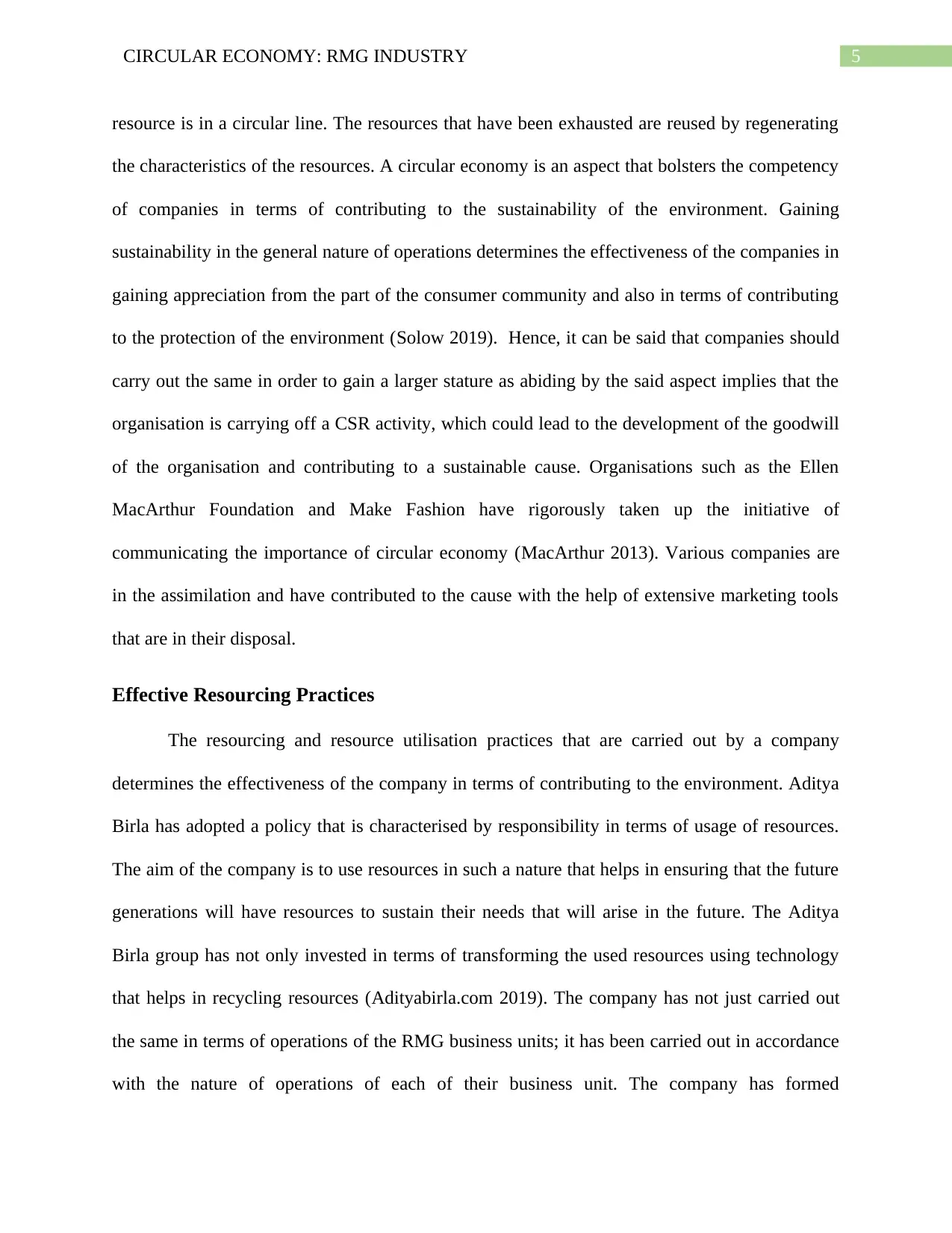
5CIRCULAR ECONOMY: RMG INDUSTRY
resource is in a circular line. The resources that have been exhausted are reused by regenerating
the characteristics of the resources. A circular economy is an aspect that bolsters the competency
of companies in terms of contributing to the sustainability of the environment. Gaining
sustainability in the general nature of operations determines the effectiveness of the companies in
gaining appreciation from the part of the consumer community and also in terms of contributing
to the protection of the environment (Solow 2019). Hence, it can be said that companies should
carry out the same in order to gain a larger stature as abiding by the said aspect implies that the
organisation is carrying off a CSR activity, which could lead to the development of the goodwill
of the organisation and contributing to a sustainable cause. Organisations such as the Ellen
MacArthur Foundation and Make Fashion have rigorously taken up the initiative of
communicating the importance of circular economy (MacArthur 2013). Various companies are
in the assimilation and have contributed to the cause with the help of extensive marketing tools
that are in their disposal.
Effective Resourcing Practices
The resourcing and resource utilisation practices that are carried out by a company
determines the effectiveness of the company in terms of contributing to the environment. Aditya
Birla has adopted a policy that is characterised by responsibility in terms of usage of resources.
The aim of the company is to use resources in such a nature that helps in ensuring that the future
generations will have resources to sustain their needs that will arise in the future. The Aditya
Birla group has not only invested in terms of transforming the used resources using technology
that helps in recycling resources (Adityabirla.com 2019). The company has not just carried out
the same in terms of operations of the RMG business units; it has been carried out in accordance
with the nature of operations of each of their business unit. The company has formed
resource is in a circular line. The resources that have been exhausted are reused by regenerating
the characteristics of the resources. A circular economy is an aspect that bolsters the competency
of companies in terms of contributing to the sustainability of the environment. Gaining
sustainability in the general nature of operations determines the effectiveness of the companies in
gaining appreciation from the part of the consumer community and also in terms of contributing
to the protection of the environment (Solow 2019). Hence, it can be said that companies should
carry out the same in order to gain a larger stature as abiding by the said aspect implies that the
organisation is carrying off a CSR activity, which could lead to the development of the goodwill
of the organisation and contributing to a sustainable cause. Organisations such as the Ellen
MacArthur Foundation and Make Fashion have rigorously taken up the initiative of
communicating the importance of circular economy (MacArthur 2013). Various companies are
in the assimilation and have contributed to the cause with the help of extensive marketing tools
that are in their disposal.
Effective Resourcing Practices
The resourcing and resource utilisation practices that are carried out by a company
determines the effectiveness of the company in terms of contributing to the environment. Aditya
Birla has adopted a policy that is characterised by responsibility in terms of usage of resources.
The aim of the company is to use resources in such a nature that helps in ensuring that the future
generations will have resources to sustain their needs that will arise in the future. The Aditya
Birla group has not only invested in terms of transforming the used resources using technology
that helps in recycling resources (Adityabirla.com 2019). The company has not just carried out
the same in terms of operations of the RMG business units; it has been carried out in accordance
with the nature of operations of each of their business unit. The company has formed
⊘ This is a preview!⊘
Do you want full access?
Subscribe today to unlock all pages.

Trusted by 1+ million students worldwide
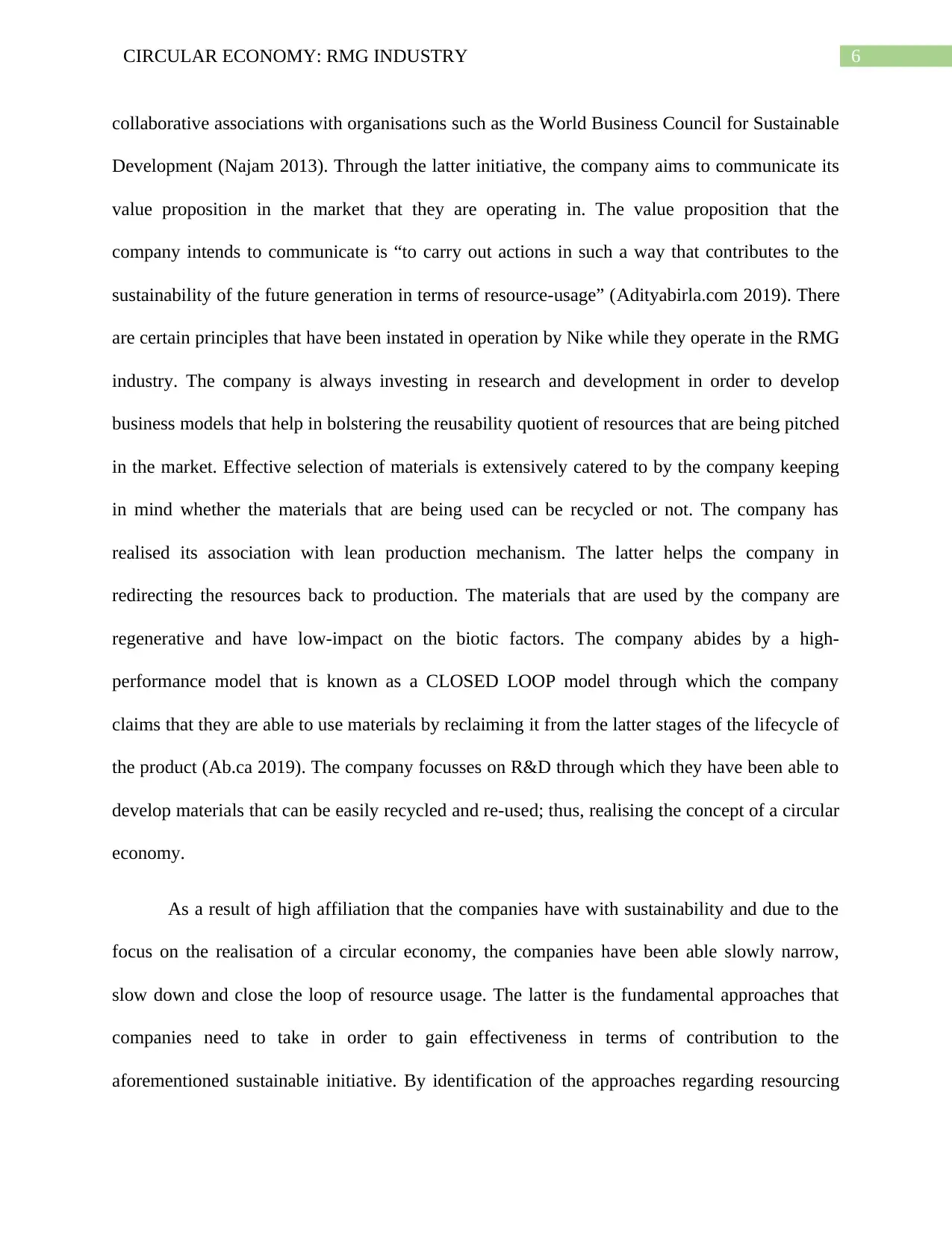
6CIRCULAR ECONOMY: RMG INDUSTRY
collaborative associations with organisations such as the World Business Council for Sustainable
Development (Najam 2013). Through the latter initiative, the company aims to communicate its
value proposition in the market that they are operating in. The value proposition that the
company intends to communicate is “to carry out actions in such a way that contributes to the
sustainability of the future generation in terms of resource-usage” (Adityabirla.com 2019). There
are certain principles that have been instated in operation by Nike while they operate in the RMG
industry. The company is always investing in research and development in order to develop
business models that help in bolstering the reusability quotient of resources that are being pitched
in the market. Effective selection of materials is extensively catered to by the company keeping
in mind whether the materials that are being used can be recycled or not. The company has
realised its association with lean production mechanism. The latter helps the company in
redirecting the resources back to production. The materials that are used by the company are
regenerative and have low-impact on the biotic factors. The company abides by a high-
performance model that is known as a CLOSED LOOP model through which the company
claims that they are able to use materials by reclaiming it from the latter stages of the lifecycle of
the product (Ab.ca 2019). The company focusses on R&D through which they have been able to
develop materials that can be easily recycled and re-used; thus, realising the concept of a circular
economy.
As a result of high affiliation that the companies have with sustainability and due to the
focus on the realisation of a circular economy, the companies have been able slowly narrow,
slow down and close the loop of resource usage. The latter is the fundamental approaches that
companies need to take in order to gain effectiveness in terms of contribution to the
aforementioned sustainable initiative. By identification of the approaches regarding resourcing
collaborative associations with organisations such as the World Business Council for Sustainable
Development (Najam 2013). Through the latter initiative, the company aims to communicate its
value proposition in the market that they are operating in. The value proposition that the
company intends to communicate is “to carry out actions in such a way that contributes to the
sustainability of the future generation in terms of resource-usage” (Adityabirla.com 2019). There
are certain principles that have been instated in operation by Nike while they operate in the RMG
industry. The company is always investing in research and development in order to develop
business models that help in bolstering the reusability quotient of resources that are being pitched
in the market. Effective selection of materials is extensively catered to by the company keeping
in mind whether the materials that are being used can be recycled or not. The company has
realised its association with lean production mechanism. The latter helps the company in
redirecting the resources back to production. The materials that are used by the company are
regenerative and have low-impact on the biotic factors. The company abides by a high-
performance model that is known as a CLOSED LOOP model through which the company
claims that they are able to use materials by reclaiming it from the latter stages of the lifecycle of
the product (Ab.ca 2019). The company focusses on R&D through which they have been able to
develop materials that can be easily recycled and re-used; thus, realising the concept of a circular
economy.
As a result of high affiliation that the companies have with sustainability and due to the
focus on the realisation of a circular economy, the companies have been able slowly narrow,
slow down and close the loop of resource usage. The latter is the fundamental approaches that
companies need to take in order to gain effectiveness in terms of contribution to the
aforementioned sustainable initiative. By identification of the approaches regarding resourcing
Paraphrase This Document
Need a fresh take? Get an instant paraphrase of this document with our AI Paraphraser
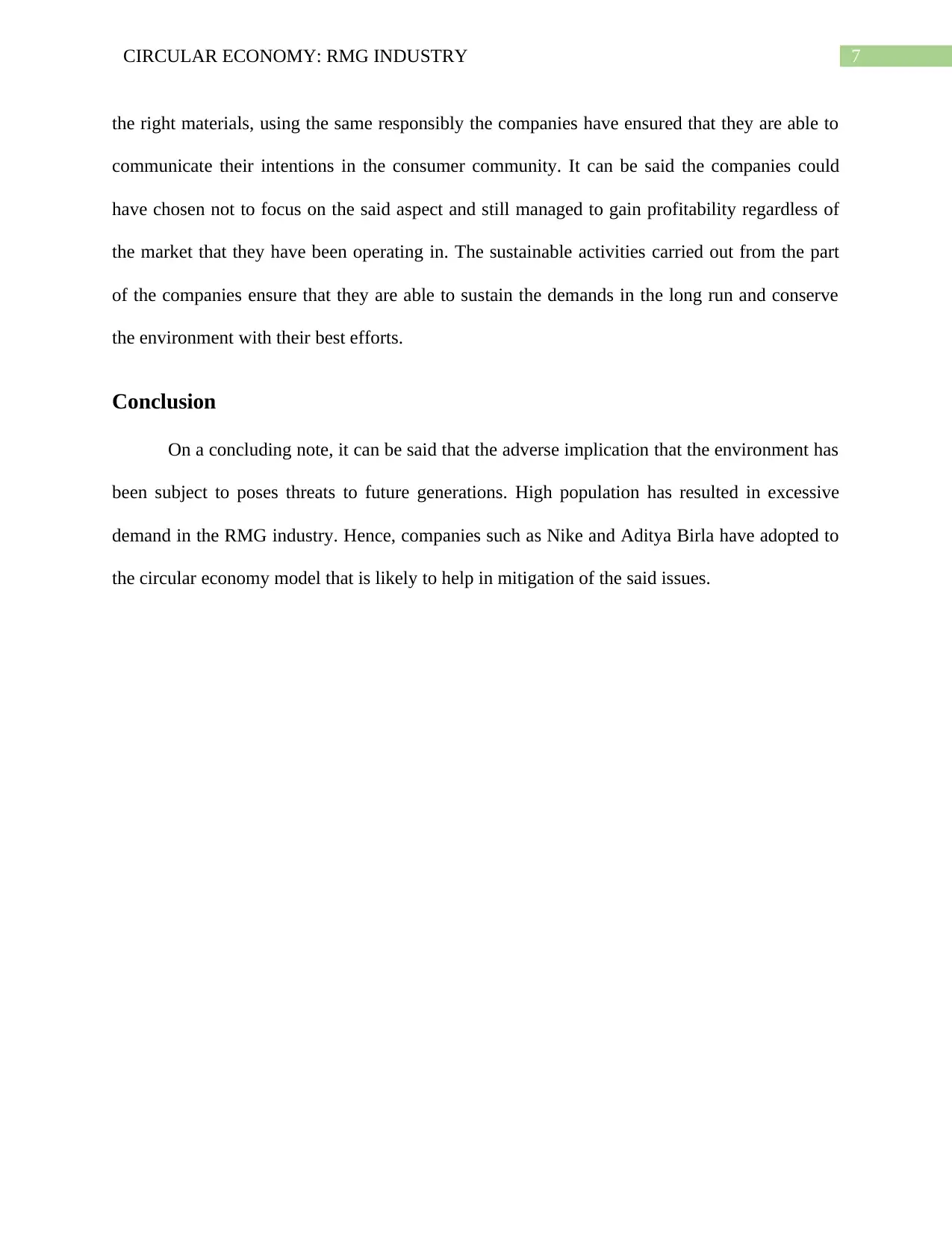
7CIRCULAR ECONOMY: RMG INDUSTRY
the right materials, using the same responsibly the companies have ensured that they are able to
communicate their intentions in the consumer community. It can be said the companies could
have chosen not to focus on the said aspect and still managed to gain profitability regardless of
the market that they have been operating in. The sustainable activities carried out from the part
of the companies ensure that they are able to sustain the demands in the long run and conserve
the environment with their best efforts.
Conclusion
On a concluding note, it can be said that the adverse implication that the environment has
been subject to poses threats to future generations. High population has resulted in excessive
demand in the RMG industry. Hence, companies such as Nike and Aditya Birla have adopted to
the circular economy model that is likely to help in mitigation of the said issues.
the right materials, using the same responsibly the companies have ensured that they are able to
communicate their intentions in the consumer community. It can be said the companies could
have chosen not to focus on the said aspect and still managed to gain profitability regardless of
the market that they have been operating in. The sustainable activities carried out from the part
of the companies ensure that they are able to sustain the demands in the long run and conserve
the environment with their best efforts.
Conclusion
On a concluding note, it can be said that the adverse implication that the environment has
been subject to poses threats to future generations. High population has resulted in excessive
demand in the RMG industry. Hence, companies such as Nike and Aditya Birla have adopted to
the circular economy model that is likely to help in mitigation of the said issues.
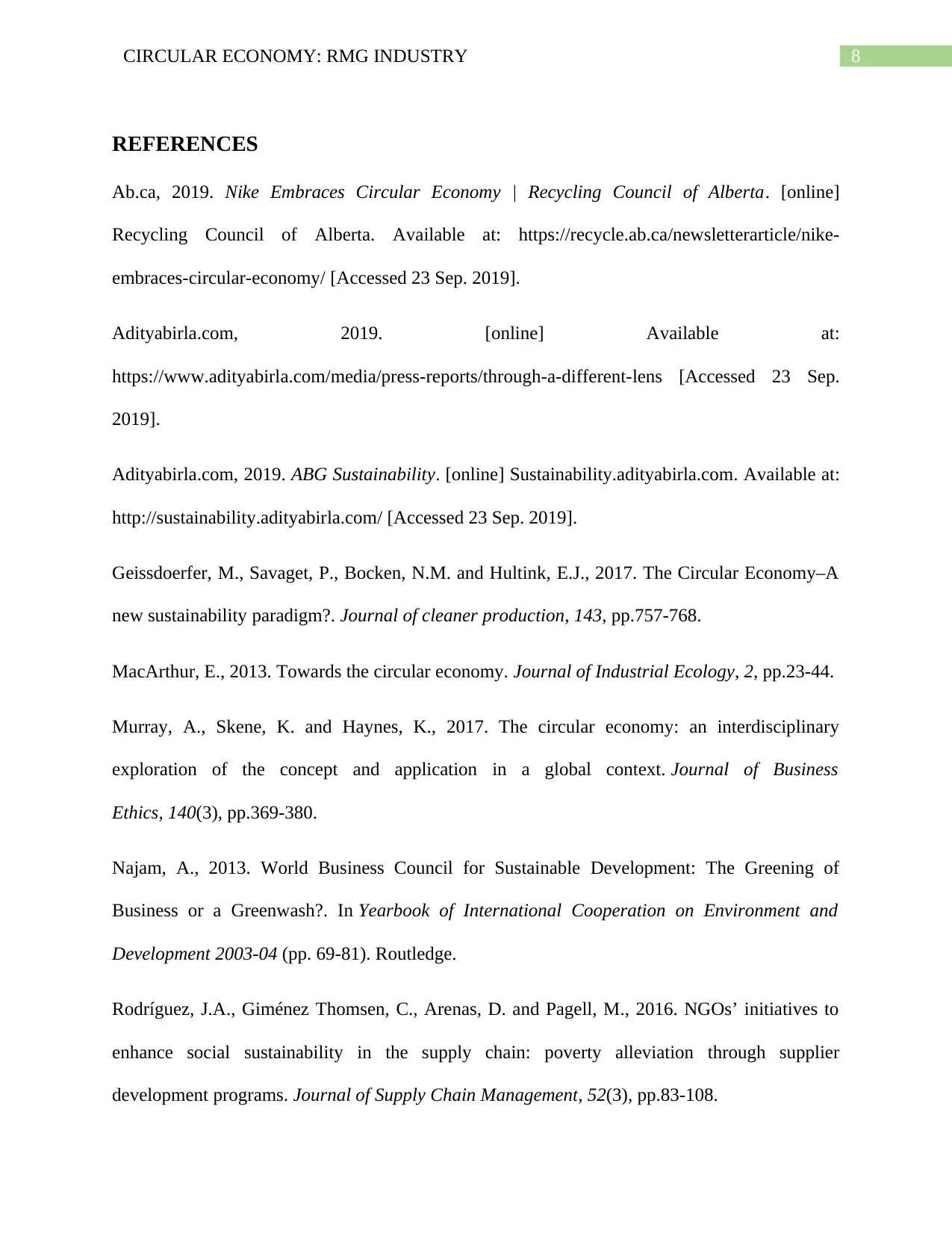
8CIRCULAR ECONOMY: RMG INDUSTRY
REFERENCES
Ab.ca, 2019. Nike Embraces Circular Economy | Recycling Council of Alberta. [online]
Recycling Council of Alberta. Available at: https://recycle.ab.ca/newsletterarticle/nike-
embraces-circular-economy/ [Accessed 23 Sep. 2019].
Adityabirla.com, 2019. [online] Available at:
https://www.adityabirla.com/media/press-reports/through-a-different-lens [Accessed 23 Sep.
2019].
Adityabirla.com, 2019. ABG Sustainability. [online] Sustainability.adityabirla.com. Available at:
http://sustainability.adityabirla.com/ [Accessed 23 Sep. 2019].
Geissdoerfer, M., Savaget, P., Bocken, N.M. and Hultink, E.J., 2017. The Circular Economy–A
new sustainability paradigm?. Journal of cleaner production, 143, pp.757-768.
MacArthur, E., 2013. Towards the circular economy. Journal of Industrial Ecology, 2, pp.23-44.
Murray, A., Skene, K. and Haynes, K., 2017. The circular economy: an interdisciplinary
exploration of the concept and application in a global context. Journal of Business
Ethics, 140(3), pp.369-380.
Najam, A., 2013. World Business Council for Sustainable Development: The Greening of
Business or a Greenwash?. In Yearbook of International Cooperation on Environment and
Development 2003-04 (pp. 69-81). Routledge.
Rodríguez, J.A., Giménez Thomsen, C., Arenas, D. and Pagell, M., 2016. NGOs’ initiatives to
enhance social sustainability in the supply chain: poverty alleviation through supplier
development programs. Journal of Supply Chain Management, 52(3), pp.83-108.
REFERENCES
Ab.ca, 2019. Nike Embraces Circular Economy | Recycling Council of Alberta. [online]
Recycling Council of Alberta. Available at: https://recycle.ab.ca/newsletterarticle/nike-
embraces-circular-economy/ [Accessed 23 Sep. 2019].
Adityabirla.com, 2019. [online] Available at:
https://www.adityabirla.com/media/press-reports/through-a-different-lens [Accessed 23 Sep.
2019].
Adityabirla.com, 2019. ABG Sustainability. [online] Sustainability.adityabirla.com. Available at:
http://sustainability.adityabirla.com/ [Accessed 23 Sep. 2019].
Geissdoerfer, M., Savaget, P., Bocken, N.M. and Hultink, E.J., 2017. The Circular Economy–A
new sustainability paradigm?. Journal of cleaner production, 143, pp.757-768.
MacArthur, E., 2013. Towards the circular economy. Journal of Industrial Ecology, 2, pp.23-44.
Murray, A., Skene, K. and Haynes, K., 2017. The circular economy: an interdisciplinary
exploration of the concept and application in a global context. Journal of Business
Ethics, 140(3), pp.369-380.
Najam, A., 2013. World Business Council for Sustainable Development: The Greening of
Business or a Greenwash?. In Yearbook of International Cooperation on Environment and
Development 2003-04 (pp. 69-81). Routledge.
Rodríguez, J.A., Giménez Thomsen, C., Arenas, D. and Pagell, M., 2016. NGOs’ initiatives to
enhance social sustainability in the supply chain: poverty alleviation through supplier
development programs. Journal of Supply Chain Management, 52(3), pp.83-108.
⊘ This is a preview!⊘
Do you want full access?
Subscribe today to unlock all pages.

Trusted by 1+ million students worldwide

9CIRCULAR ECONOMY: RMG INDUSTRY
Solow, R.M., 2019. 25. Sustainability: an economist’s perspective. Economics of the
environment: Selected readings.
Yang, W., Williams, J.H., Hogan, P.F., Bruinooge, S.S., Rodriguez, G.I., Kosty, M.P., Bajorin,
D.F., Hanley, A., Muchow, A., McMillan, N. and Goldstein, M., 2014. Projected supply of and
demand for oncologists and radiation oncologists through 2025: ageing, better-insured
population will result in shortage — Journal of oncology practice, 10(1), pp.39-45.
Solow, R.M., 2019. 25. Sustainability: an economist’s perspective. Economics of the
environment: Selected readings.
Yang, W., Williams, J.H., Hogan, P.F., Bruinooge, S.S., Rodriguez, G.I., Kosty, M.P., Bajorin,
D.F., Hanley, A., Muchow, A., McMillan, N. and Goldstein, M., 2014. Projected supply of and
demand for oncologists and radiation oncologists through 2025: ageing, better-insured
population will result in shortage — Journal of oncology practice, 10(1), pp.39-45.
1 out of 10
Related Documents
Your All-in-One AI-Powered Toolkit for Academic Success.
+13062052269
info@desklib.com
Available 24*7 on WhatsApp / Email
![[object Object]](/_next/static/media/star-bottom.7253800d.svg)
Unlock your academic potential
Copyright © 2020–2025 A2Z Services. All Rights Reserved. Developed and managed by ZUCOL.





